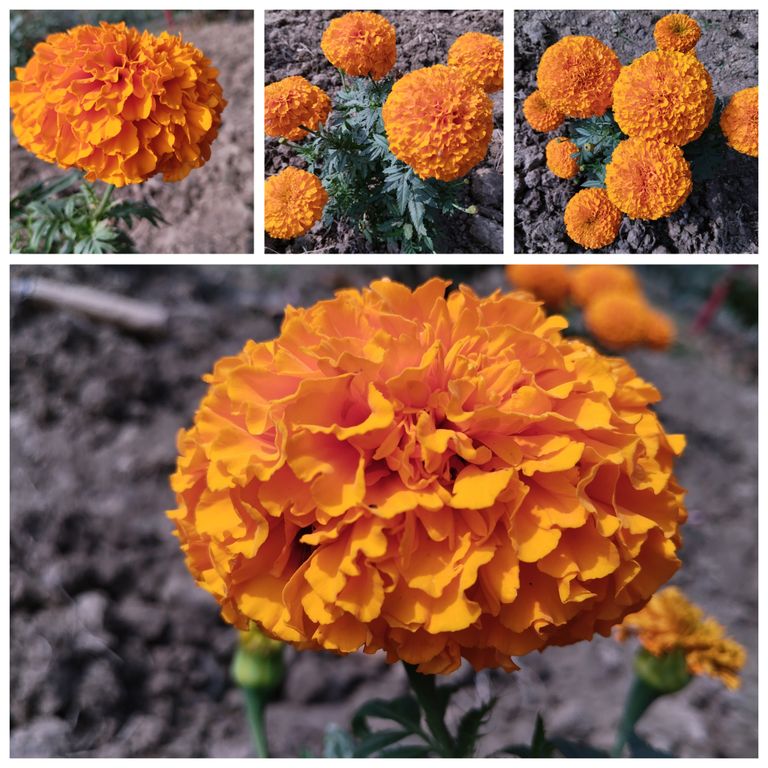
The Beauty of Marigold Flowers.
Marigold flowers, often referred to as the "golden gems of the garden," are celebrated worldwide for their vibrant colors, rich symbolism, and numerous uses. Their scientific name, Tagetes, derives from the Etruscan deity Tages, signifying divinity and beauty. Marigolds have been cultivated for centuries and are deeply rooted in various cultures, rituals, and traditions. Let’s explore their allure and significance in detail.
A Burst of Color and Elegance
The most striking feature of marigold flowers is their brilliant array of colors. Ranging from golden yellow to fiery orange and even deep red, marigolds brighten up any space. Their vibrant hues evoke feelings of warmth, energy, and positivity. Whether planted in gardens, grown in pots, or used as decorative garlands, these flowers add a lively touch to their surroundings.
The unique petal structure of marigolds, often resembling the sun, makes them a favorite among gardeners. Their densely packed blooms create a mesmerizing effect, making them stand out in any floral arrangement.
Types of Marigolds
Marigolds are primarily divided into two main categories:
- African Marigolds (Tagetes erecta): Known for their large, pom-pom-like flowers, these marigolds are often used in floral decorations.
- French Marigolds (Tagetes patula): These are smaller, more compact varieties with delicate, intricate petals.
Both types are loved for their hardy nature and ability to thrive in various climates.
Cultural and Spiritual Significance
Marigold flowers hold immense cultural and spiritual importance in many parts of the world:
India: Marigolds are considered sacred in Hindu rituals. They are used to decorate temples, homes, and altars during festivals like Diwali and Durga Puja. The flower is also a symbol of the sun, representing life, creativity, and energy.
Mexico: Marigolds are an integral part of Día de los Muertos (Day of the Dead) celebrations. Known as "cempasúchil," they are believed to guide the spirits of the departed back to the living world with their bright colors and strong fragrance.
Europe and the United States: Marigolds symbolize cheerfulness and are often associated with the idea of affection and gratitude.
Symbolism and Meaning
Marigolds carry a rich tapestry of meanings, including:
Resilience and determination: Their ability to thrive in harsh conditions symbolizes strength.
Love and passion: Their fiery hues reflect strong emotions.
Grief and remembrance: In some cultures, they represent the transient nature of life.
Horticultural Benefits
Marigolds are not just beautiful; they are also incredibly practical in the garden. They are known for their pest-repelling properties. Marigold roots release a natural chemical that deters nematodes and other harmful insects, making them a natural companion plant in vegetable gardens.
Additionally, marigolds are easy to grow and require minimal care, making them perfect for novice gardeners. They thrive in sunny spots with well-draining soil and bloom profusely with regular watering.
Medicinal and Culinary Uses
Beyond their ornamental value, marigolds have medicinal properties. The petals contain antioxidants and are used in traditional medicine to treat wounds, inflammation, and skin conditions. Marigold tea, made from dried petals, is known for its calming effects and ability to boost immunity.
In the culinary world, marigold petals are sometimes used as a natural food coloring or to add a mild, peppery flavor to salads and dishes.
Marigolds in Art and Literature
Marigolds have inspired countless poets, artists, and writers. Their bold colors and intricate patterns make them a popular subject in paintings and photography. In literature, marigolds often symbolize fleeting beauty, love, and the cycle of life and death.
Marigold flowers are more than just a feast for the eyes. They are a symbol of cultural heritage, a gardener’s ally, and a source of inspiration and healing. Their timeless beauty continues to captivate people across the globe, reminding us of nature's power to bring joy, hope, and connection. Whether in a bustling city garden or a quiet countryside meadow, marigolds stand as a testament to the enduring charm of flowers.
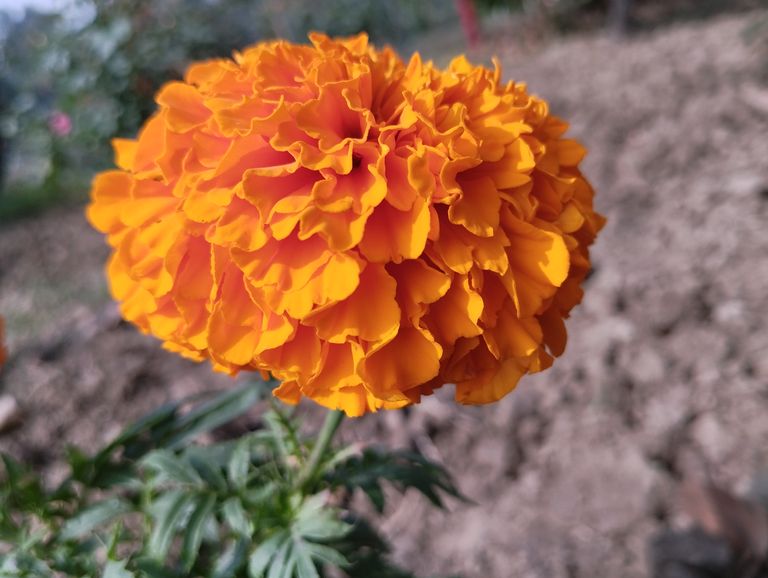
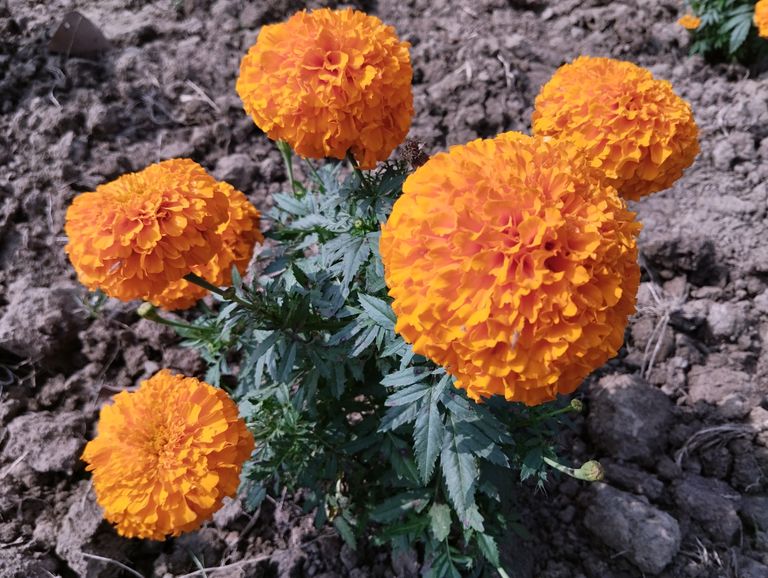
The Benefits of Marigold Petals
Marigold, known for its vibrant hues and fragrant blossoms, has been a part of traditional medicine, cosmetics, and culinary practices for centuries. This versatile flower, particularly its petals, is packed with therapeutic and practical benefits. Here’s a deep dive into the remarkable advantages of marigold petals.
- Medicinal Properties
Marigold petals are rich in antioxidants, flavonoids, and carotenoids, making them highly beneficial for health. Below are some key medicinal benefits:
a. Wound Healing
The petals contain anti-inflammatory and antiseptic properties, which make them effective in treating wounds, cuts, and bruises. They promote faster healing by stimulating collagen production and reducing swelling.
b. Skin Health
Marigold is often used in skincare products because of its ability to soothe and hydrate the skin. It helps in treating acne, eczema, and rashes. The petals’ anti-inflammatory properties reduce redness and irritation, making them an excellent remedy for sensitive skin.
c. Eye Care
Rich in lutein and zeaxanthin, marigold petals protect the eyes from harmful blue light and oxidative stress. These compounds are essential for maintaining healthy vision and preventing conditions like macular degeneration.
d. Digestive Aid
Marigold petals have been used in traditional medicine to treat digestive issues like ulcers, gastritis, and indigestion. They help in reducing inflammation in the stomach lining and improve overall gut health.
- Culinary Uses
Marigold petals are not just decorative; they are also edible and offer a unique flavor to dishes. Known as the "poor man's saffron," marigold petals are often used as a natural food coloring agent and seasoning.
a. Herbal Teas
Dried marigold petals are used to make herbal teas that are not only refreshing but also packed with health benefits. These teas help in detoxifying the body and improving digestion.
b. Salads and Garnishes
The petals add a burst of color and a slightly tangy flavor to salads. They are often used as garnishes to elevate the visual appeal of dishes.
c. Natural Food Coloring
The vibrant orange and yellow pigments in marigold petals are used as a natural dye in culinary preparations, giving a golden hue to soups, rice, and desserts.
- Cosmetic Applications
The beauty industry has long embraced marigold petals for their skin-enhancing properties. Here are some common uses:
a. Natural Moisturizer
Infused oils and creams made from marigold petals deeply nourish and moisturize the skin, making it soft and supple.
b. Anti-Aging Benefits
The antioxidants in marigold fight free radicals, reducing the appearance of wrinkles and fine lines. Regular use of marigold-infused products can help in maintaining youthful skin.
c. Hair Care
Marigold extracts are used in shampoos and conditioners to promote hair growth and add shine. They also help in treating scalp issues like dandruff and itchiness.
- Environmental and Gardening Benefits
Marigold petals are not just beneficial for humans; they also play a significant role in gardening and environmental sustainability.
a. Natural Pest Repellent
Marigold plants, including their petals, are known to repel pests like aphids, mosquitoes, and nematodes. This makes them a popular choice in organic gardening.
b. Composting
The petals decompose easily and add essential nutrients to the soil when used as compost. This helps in improving soil fertility and plant health.
c. Pollinator Attraction
The bright colors and fragrance of marigold flowers attract bees and butterflies, aiding in pollination and promoting biodiversity.
- Spiritual and Cultural Significance
Marigold holds a special place in various cultures and traditions. Its petals are often used in religious ceremonies, decorations, and offerings.
a. Aroma Therapy
The pleasant fragrance of marigold petals is used in aromatherapy to reduce stress and anxiety. The petals’ calming effect can uplift mood and promote relaxation.
b. Symbolism
Marigold symbolizes warmth, creativity, and passion. It is often used in festivals and weddings to signify prosperity and happiness.
Marigold petals, with their plethora of benefits, are truly nature’s gift. From enhancing health and beauty to supporting the environment, these golden blossoms have much to offer. Incorporating marigold petals into your daily routine can bring a touch of natural wellness and beauty to your life. Whether you use them in teas, skincare, or gardening, their vibrant energy and therapeutic properties are sure to leave a lasting impact.
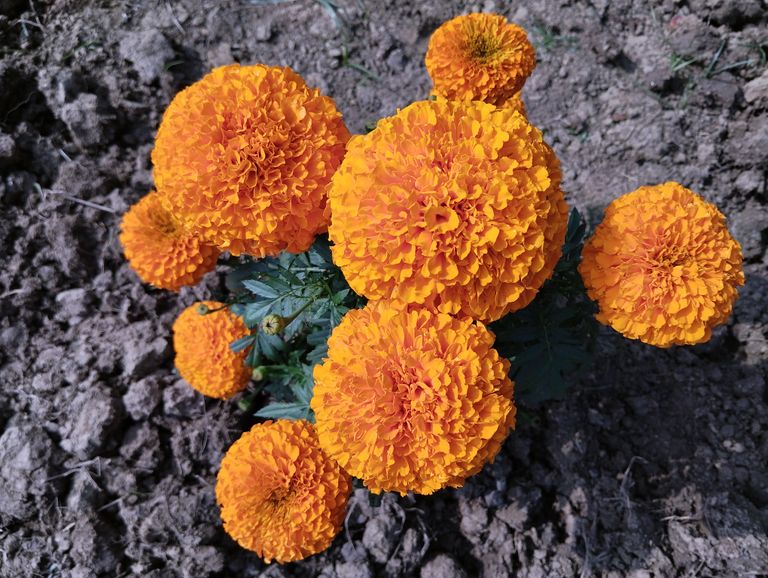
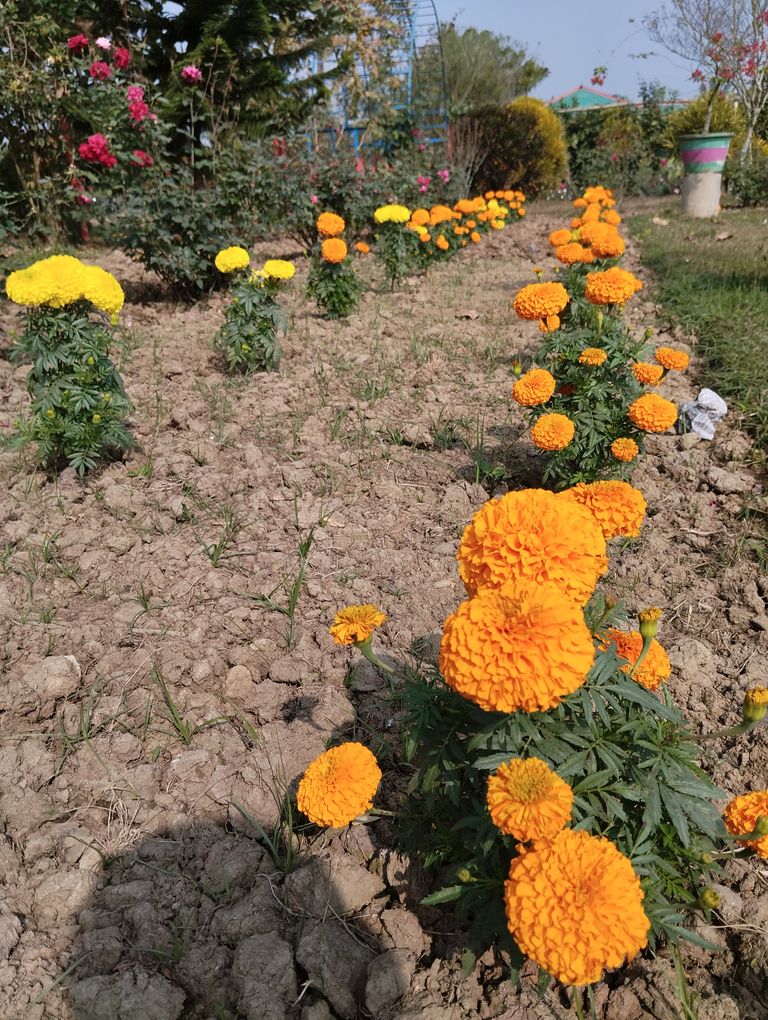
Selecting the Right Varieties of Marigold for Cultivation
Marigold flowers are widely celebrated for their vibrant colors, ease of cultivation, and versatility in use. These flowers are not only beautiful but also play an essential role in religious, ornamental, and commercial applications. If you're planning to cultivate marigold flowers, selecting the right variety is a crucial step. This blog will guide you through the process of choosing the ideal marigold varieties for your specific needs and growing conditions.
Types of Marigold
Marigolds are broadly classified into two main types based on their origin and flower characteristics:
- African Marigold (Tagetes erecta):
Appearance: Large, round, and ball-shaped flowers.
Colors: Predominantly yellow and orange.
Growth Habit: Taller plants, ranging from 60–90 cm in height.
Uses: Ideal for garlands, decorations, and large flower arrangements.
Popular Varieties: Pusa Basanti Gainda, Pusa Narangi Gainda, and African Gold.
- French Marigold (Tagetes patula):
Appearance: Small to medium-sized flowers with a bushier plant habit.
Colors: A mix of orange, red, yellow, and bi-colored flowers.
Growth Habit: Shorter plants, usually 15–30 cm in height.
Uses: Perfect for borders, bedding plants, and ornamental gardens.
Popular Varieties: Red Brocade, Golden Gate, and Little Hero.
- Hybrid Marigold:
These are crossbreeds of African and French marigolds, combining the best traits of both.
Features: Intermediate size, disease resistance, and diverse color options.
Examples: First Lady, Nugget, and Safari series.
Factors to Consider When Selecting Marigold Varieties
- Purpose of Cultivation:
For Commercial Use: If you aim to produce marigolds for garlands or bulk flower markets, African marigolds are your best choice due to their larger blooms and higher yield.
For Ornamental Gardening: French marigolds, with their compact size and vibrant colors, are ideal for landscaping and home gardens.
For Mixed Purposes: Hybrid marigolds provide a balance between aesthetic appeal and commercial viability.
- Climate and Soil Conditions:
Marigolds thrive in warm climates with plenty of sunlight.
African Marigolds: Perform well in slightly warmer regions.
French Marigolds: Adapt better to cooler climates and can tolerate some shade.
Ensure well-drained soil with a pH of 6.0–7.5 for optimal growth.
- Plant Height and Space Requirements:
African marigolds grow taller and need more spacing (40–50 cm between plants).
French marigolds are compact and require less spacing (20–30 cm between plants).
- Flowering Season and Duration:
Some varieties bloom earlier than others. For continuous flowering, opt for hybrids or a mix of African and French marigolds.
African marigolds typically bloom during summer, while French marigolds can bloom throughout the year in favorable conditions.
- Pest and Disease Resistance:
Choose varieties known for their resistance to common pests and diseases like aphids, spider mites, and fungal infections. Hybrids often have better resistance compared to traditional varieties.
- Market Demand:
Research the market trends in your area. Yellow and orange marigolds generally have higher demand for festivals and religious ceremonies.
Popular Marigold Varieties in India
- Pusa Narangi Gainda:
Large, orange blooms.
Suitable for garland making and mass plantations.
- Pusa Basanti Gainda:
Light yellow flowers with excellent yield.
Ideal for decorations and religious offerings.
- Crackerjack:
A mix of orange, yellow, and gold blooms.
Highly popular for commercial cultivation.
- Red Brocade (French):
Compact plants with deep red and yellow bi-colored flowers.
Perfect for gardens and borders.
- Safari Series (Hybrid):
Offers a range of vibrant colors and patterns.
Resistant to common pests and diseases.
Final Tips for Successful Cultivation
Seed Selection: Always purchase seeds from trusted suppliers to ensure high germination rates and disease-free plants.
Soil Preparation: Enrich the soil with organic compost or well-rotted manure before planting.
Watering: Marigolds are drought-tolerant but require consistent watering during flowering for better yield.
Fertilization: Use a balanced NPK fertilizer to promote healthy growth and flowering.
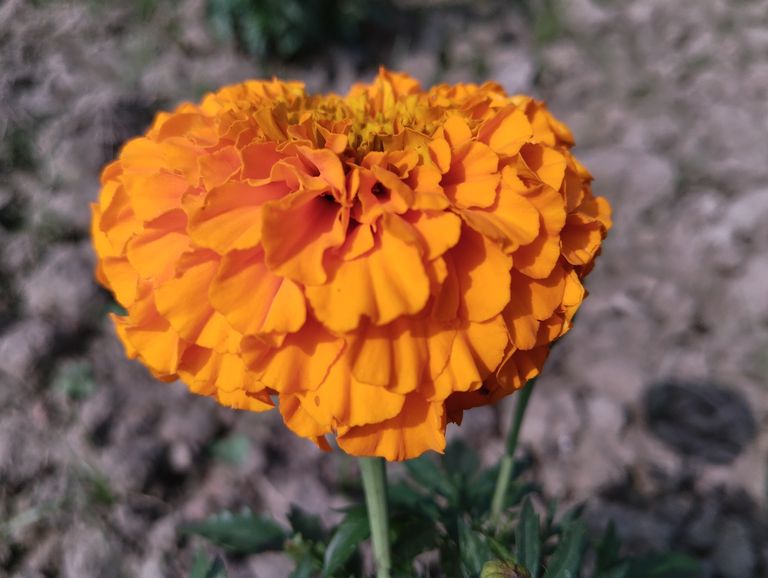
How to Create a Marigold Garden: A Step-by-Step Guide.
Marigolds are one of the most popular and vibrant flowers for gardens worldwide. Known for their bright colors, ease of care, and ability to deter pests, marigolds are a gardener's delight. Whether you are a beginner or an experienced gardener, creating a marigold garden can be an enriching experience. In this blog, we’ll guide you through the process of planning, planting, and maintaining a marigold garden.
Why Choose Marigolds?
Marigolds (Tagetes) are ideal for gardens due to their adaptability and striking appearance. Here are some reasons to consider marigolds:
- Low Maintenance: Marigolds thrive in various soil types and climates.
- Pest Repellent: They deter pests like aphids, nematodes, and mosquitoes.
- Aesthetic Appeal: Their vibrant colors, including orange, yellow, and red, brighten any garden.
- Companion Planting: Marigolds enhance the growth of other plants by improving soil health and warding off pests.
Step-by-Step Guide to Create a Marigold Garden
- Selecting the Right Variety
Marigolds come in various types, each suitable for different purposes:
African Marigolds (Tagetes erecta): Taller with large blooms, ideal for garden beds.
French Marigolds (Tagetes patula): Compact and bushy, perfect for borders and pots.
Signet Marigolds (Tagetes tenuifolia): Delicate flowers with a citrusy scent, great for edible gardens.
Choose a variety based on your garden space and aesthetic preferences.
- Choosing the Right Location
Marigolds thrive in sunny locations. They require at least 6-8 hours of direct sunlight daily. Ensure the garden area has good air circulation and is protected from excessive wind.
- Preparing the Soil
Marigolds are not fussy about soil but prefer well-draining, moderately fertile soil.
pH Level: Aim for a pH between 6.0 and 7.0.
Enrich the Soil: Mix organic compost or aged manure to enhance fertility. Avoid over-fertilizing, as it can reduce flower production.
- Planting Marigolds
You can grow marigolds from seeds or nursery-bought seedlings.
From Seeds:
- Start indoors 4-6 weeks before the last frost or directly sow seeds in the garden after the frost.
- Plant seeds 1/4 inch deep and 1 inch apart.
- Keep the soil moist until seedlings emerge in 7-14 days.
From Seedlings:
- Transplant seedlings to the garden when they are 2-3 inches tall.
- Space African marigolds 10-12 inches apart and French marigolds 6-9 inches apart.
- Watering and Care
Watering: Marigolds need moderate watering. Water deeply but infrequently, allowing the soil to dry between waterings. Avoid overhead watering to prevent fungal issues.
Deadheading: Remove faded flowers regularly to encourage continuous blooming.
Mulching: Apply organic mulch to retain soil moisture and prevent weeds.
- Protecting Your Marigolds
Though marigolds deter many pests, they can still face issues like:
Aphids and Spider Mites: Use neem oil or insecticidal soap.
Fungal Diseases: Ensure good air circulation and avoid overwatering.
Snails and Slugs: Use natural deterrents like crushed eggshells around plants.
- Enhancing Your Garden
To make your marigold garden even more stunning:
Combine marigolds with companion plants like tomatoes, peppers, or herbs.
Create patterns with different marigold varieties.
Add decorative elements like garden paths, edging, or pots.
Harvesting and Uses of Marigolds
Marigolds are not just ornamental; they have practical uses too:
- Religious and Cultural Use: Widely used in festivals and rituals.
- Medicinal Properties: Known for their anti-inflammatory and antiseptic properties.
- Edible Flowers: Add to salads or teas (Signet marigolds).
- Natural Dye: Use the petals to create yellow or orange dye.
Common Mistakes to Avoid
- Overwatering, leading to root rot.
- Planting in shaded areas with insufficient sunlight.
- Using excessive fertilizer, which promotes foliage over flowers.
Creating a marigold garden is a rewarding experience. With minimal effort, you can enjoy vibrant blooms that beautify your space and provide multiple benefits. Follow this guide to cultivate a thriving marigold garden that stands out in any season. Happy gardening.